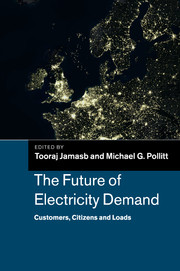Book contents
- Frontmatter
- Contents
- List of Figures
- List of Tables
- List of Boxes
- List of Contributors
- Foreword
- Preface
- Acknowledgements
- Introduction and overview of the chapters
- Part I The economics
- 1 The economics of energy (and electricity) demand
- 2 Energy scenarios and implications for future electricity demand
- 3 Demand-side participation: price constraints, technical limits and behavioural risks
- 4 Review of recent developments in economic modelling of energy demand
- Part II Technology
- Part III Social dimensions
- Part IV Policy and regulation
- Index
- References
3 - Demand-side participation: price constraints, technical limits and behavioural risks
from Part I - The economics
Published online by Cambridge University Press: 05 March 2014
- Frontmatter
- Contents
- List of Figures
- List of Tables
- List of Boxes
- List of Contributors
- Foreword
- Preface
- Acknowledgements
- Introduction and overview of the chapters
- Part I The economics
- 1 The economics of energy (and electricity) demand
- 2 Energy scenarios and implications for future electricity demand
- 3 Demand-side participation: price constraints, technical limits and behavioural risks
- 4 Review of recent developments in economic modelling of energy demand
- Part II Technology
- Part III Social dimensions
- Part IV Policy and regulation
- Index
- References
Summary
Introduction
Demand response in domestic contexts may be differentiated into two modes of provision. First, ‘automatic’ load control involves the direct intervention by utilities to manipulate the performance of domestic appliances using heat or power, without the immediate involvement of domestic end-users. This is sometimes referred to as ‘dynamic demand’. For example, in the UK a trial was initiated in December 2009 by a consortium including a fridge manufacturer (Indesit), an energy utility (Npower) and a technology company (RLtec). Three hundred end-users were supplied with ‘dynamic demand fridges and fridge freezers’, free of charge and the trial involved the monitoring of each device as well as the switching off of appliances for short durations in response to grid conditions.
A second form of demand response can be described as more ‘intentional’ load control. This involves the direct intervention by domestic end-users themselves, rather than utilities, that would retain total control over the working of domestic appliances and would choose to modify behavioural patterns of energy consumption in response to some form of signal from a utility. This signal is most likely to be a price signal but is not necessarily so – it could involve communicating the availability of energy generated from different kinds of resource (e.g. fossil fuel or renewable) (Devine-Wright, 2003). The signal is most likely to be communicated via a smart metering device, but could alternatively involve a ‘traffic light’ device that signals the availability of energy via colour-coded signals, or a communication to other forms of ICT via text messages or emails (e.g. mobile phones).
- Type
- Chapter
- Information
- The Future of Electricity DemandCustomers, Citizens and Loads, pp. 88 - 105Publisher: Cambridge University PressPrint publication year: 2011
References
- 6
- Cited by



